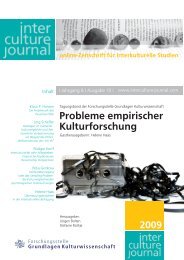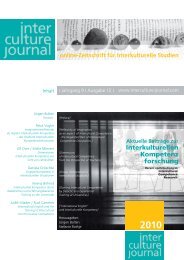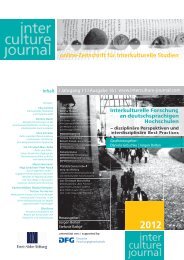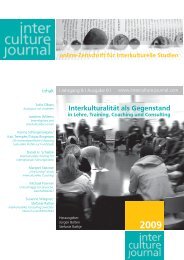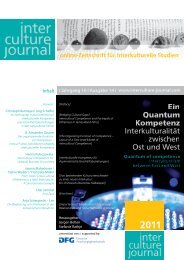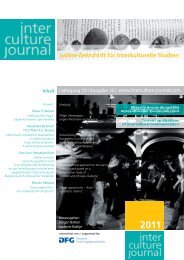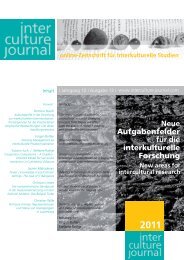Grundlagen Kulturwissenschaft - Interculture Journal
Grundlagen Kulturwissenschaft - Interculture Journal
Grundlagen Kulturwissenschaft - Interculture Journal
Erfolgreiche ePaper selbst erstellen
Machen Sie aus Ihren PDF Publikationen ein blätterbares Flipbook mit unserer einzigartigen Google optimierten e-Paper Software.
Rathje: The Definition of Culture: An application-oriented overhaul<br />
to the conclusion that cultures are "internally characterized<br />
by the pluralization of possible identities" and externally<br />
show "contours that transcend traditional borders." (Welsch<br />
1995:42, translation by author) As a result, Welsch offers a<br />
new perspective beyond existing limitations of cultural composition<br />
in his formulation of "transculturality."<br />
2. The Stubbornness of the Coherence Paradigm - The<br />
lure of simplicity<br />
"Today [the] assumptions of the traditional concept of culture<br />
have become untenable." (Welsch 1995:39, translation by<br />
author)<br />
Although contemporary scientists - even in unrelated disciplines<br />
- would agree with the above statement, the coherence<br />
paradigm of the traditional definition of culture remains<br />
stubbornly in place. Besides the obvious fact that simple<br />
structures are easier to grasp than complex or even contradictory<br />
ones, two further reasons for the remarkable ‘stickiness’<br />
of the coherence concept must be considered:<br />
Cultural uniformity is politically expedient.<br />
This assertion is nicely illustrated by two opposing concepts<br />
found in contemporary political discourse today, both being<br />
rooted in cultural models based on coherence.<br />
The concept of Leitkultur, introduced by the political scientist<br />
Bassam Tibi (2002), describes the desideratum of a consensus<br />
in social values, that is, a homogeneity of shared values<br />
within a society. The term "German Leitkultur," for example,<br />
has been employed by conservative politicians in Germany in<br />
the context of the immigration debate to elicit feelings of a<br />
disappearing common national tradition and a longing for a<br />
presumably more pristine and homogeneous world.<br />
The multicultural approach, however, frequently associated<br />
with the Canadian philosopher Charles Taylor (1993), is<br />
aimed at the protection and the recognition of cultural differences<br />
by the state. This approach would, at first glance, appear<br />
to stand in clear opposition to demands of cultural uniformity<br />
and the notion of a Leitkultur. The connotations of<br />
exoticism and the implicit fascination with the foreign along<br />
with the strengthening of the rights of suppressed or marginalized<br />
groups have likewise become politically attractive especially<br />
on the political left. Few have made the observation,<br />
however, that multiculturalism is essentially a kind of "Leitkultur<br />
in sheep's clothing." Taylor's understanding of culture<br />
is anchored in the same traditional coherence paradigm, preferring<br />
"substantive agreement on value" and "sufficient in-<br />
37<br />
© <strong>Interculture</strong> <strong>Journal</strong> 2009 | 8



